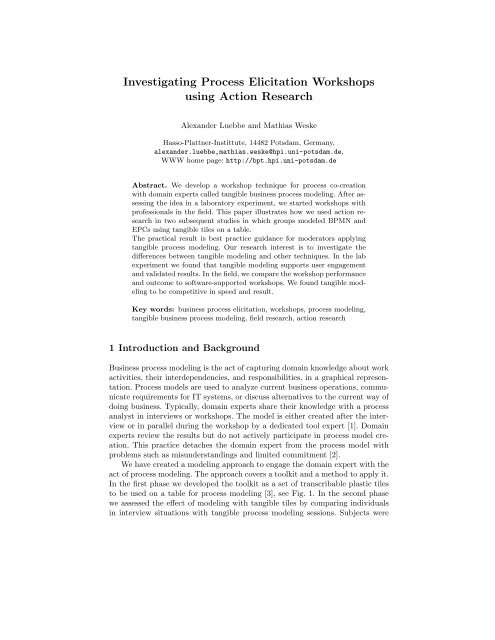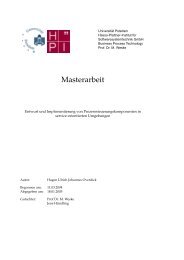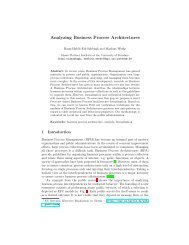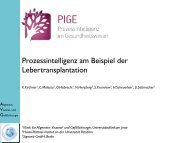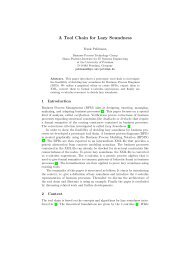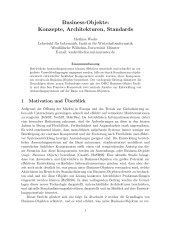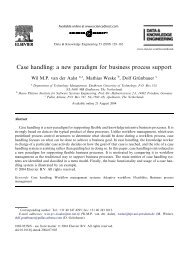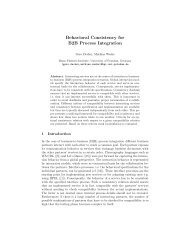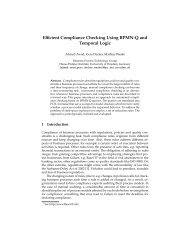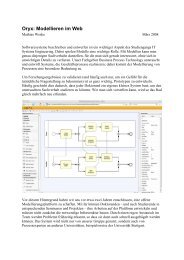Investigating Process Elicitation Workshops using Action Research
Investigating Process Elicitation Workshops using Action Research
Investigating Process Elicitation Workshops using Action Research
Create successful ePaper yourself
Turn your PDF publications into a flip-book with our unique Google optimized e-Paper software.
<strong>Investigating</strong> <strong>Process</strong> <strong>Elicitation</strong> <strong>Workshops</strong><br />
<strong>using</strong> <strong>Action</strong> <strong>Research</strong><br />
Alexander Luebbe and Mathias Weske<br />
Hasso-Plattner-Instittute, 14482 Potsdam, Germany,<br />
alexander.luebbe,mathias.weske@hpi.uni-potsdam.de,<br />
WWW home page: http://bpt.hpi.uni-potsdam.de<br />
Abstract. We develop a workshop technique for process co-creation<br />
with domain experts called tangible business process modeling. After assessing<br />
the idea in a laboratory experiment, we started workshops with<br />
professionals in the field. This paper illustrates how we used action research<br />
in two subsequent studies in which groups modeled BPMN and<br />
EPCs <strong>using</strong> tangible tiles on a table.<br />
The practical result is best practice guidance for moderators applying<br />
tangible process modeling. Our research interest is to investigate the<br />
differences between tangible modeling and other techniques. In the lab<br />
experiment we found that tangible modeling supports user engagement<br />
and validated results. In the field, we compare the workshop performance<br />
and outcome to software-supported workshops. We found tangible modeling<br />
to be competitive in speed and result.<br />
Key words: business process elicitation, workshops, process modeling,<br />
tangible business process modeling, field research, action research<br />
1 Introduction and Background<br />
Business process modeling is the act of capturing domain knowledge about work<br />
activities, their interdependencies, and responsibilities, in a graphical representation.<br />
<strong>Process</strong> models are used to analyze current business operations, communicate<br />
requirements for IT systems, or discuss alternatives to the current way of<br />
doing business. Typically, domain experts share their knowledge with a process<br />
analyst in interviews or workshops. The model is either created after the interview<br />
or in parallel during the workshop by a dedicated tool expert [1]. Domain<br />
experts review the results but do not actively participate in process model creation.<br />
This practice detaches the domain expert from the process model with<br />
problems such as misunderstandings and limited commitment [2].<br />
We have created a modeling approach to engage the domain expert with the<br />
act of process modeling. The approach covers a toolkit and a method to apply it.<br />
In the first phase we developed the toolkit as a set of transcribable plastic tiles<br />
to be used on a table for process modeling [3], see Fig. 1. In the second phase<br />
we assessed the effect of modeling with tangible tiles by comparing individuals<br />
in interview situations with tangible process modeling sessions. Subjects were
2 Alexander Luebbe, Mathias Weske<br />
t.BPM Introduction<br />
more engaged with the task. Moreover, they reviewed and corrected the model<br />
more often leading to more validated results [4].<br />
Fig. 1. tangible modeling tool set: transcribable plastic tiles reflecting the BPMN<br />
iconography<br />
The lab experiment showed positive effects of tangible modeling on individuals.<br />
The current research interest is the efficiency of group modeling workshops<br />
in reality. We aim to assess the applicability of tangible modeling in real environments<br />
and compare tangible modeling workshops with other techniques in<br />
place today.<br />
The practical goal is to derive guidance for professionals who want to leverage<br />
the theoretical potential [4] of tangible business process modeling in their<br />
workshops, namely stronger engagement and validated results. Since practical<br />
guidance can only be derived from practice, we choose action research as a<br />
method to guide our cooperation with professionals in the field.<br />
In Section 2 we introduce the idea of action research. Afterwards, we apply<br />
action research in Section 3 and Section 4 in two subsequent iterations and<br />
discuss our learnings in Section 5. Finally, we look at related empirical research<br />
in Section 6 and conclude the paper in Section 7.<br />
2 <strong>Action</strong> research – an iterative learning cycle<br />
<strong>Action</strong> research (AR) is a class of research approaches in which researchers collaborate<br />
with practitioners to act in or on a social system [5]. The goal is to<br />
solve practical problems and generate scientific knowledge. <strong>Action</strong> research assumes<br />
that complex social problems cannot be reduced to meaningful controllable<br />
studies. They need to be investigated within the context in which they<br />
appear. Therefore the system is studied, changed, and the effect of change is<br />
studied again. It is an iterative learning cycle. We adopt a five stage process<br />
proposed by e.g. Baskerville [6], see Figure 2. We also follow the principles for<br />
AR defined by Davison et al. [7] such as multiple iterations, the principle of<br />
theory, and learning through reflection.<br />
In the diagnosing step the context and problem statement are described. In<br />
action planning the desired future state and proposed changes are introduced
<strong>Investigating</strong> process elicitation workshops 3<br />
diagnosing<br />
specify learning<br />
action research<br />
cycle<br />
action planning<br />
evaluating<br />
taking action<br />
Fig. 2. <strong>Action</strong> research cycle used to guide the field studies in this paper<br />
based on theoretical background. The first two steps are carried out in close<br />
collaboration with practitioners. In taking action the practitioners act alone<br />
while the researchers observe and collect data for the evaluating phase. This<br />
phase analyses whether the proposed changes realized the intended effect and<br />
whether the practitioners’ problems were solved. The results are used to specify<br />
learning as more general knowledge, practically and scientifically. In this last<br />
step, we also develop research questions for the next iteration.<br />
3 BPMN process modeling workshop with clinical staff<br />
In mid 2009, a consultant used the tangible toolkit (see Fig. 1) to capture clinical<br />
paths in a hospital with medical staff. A clinical path is a treatment process for<br />
a class of patients with a similar disease, in this case for a certain type of cancer.<br />
It was the first application of our tangible modeling approach in the field. As<br />
researchers, we observed the situation and framed it as a case study [2]. Within<br />
one week, twenty BPMN processes were modeled together with three doctors<br />
<strong>using</strong> the tangible modeling toolkit. The workshop was considered a success by<br />
the consultant. In mid 2010, the same consultant approached us again with the<br />
same request. The setting was very similar, only the participants and the clinical<br />
path were changed. This was the starting point for the first action research cycle.<br />
Diagnosing. When reviewing the workshop from 2009 together with the consultant,<br />
we agreed that the introduction was not optimal. Originally, a one-day<br />
introduction to BPM and BPMN was given. Modeling only started on the second<br />
day. A further problem was that the workshop in 2009 got confused with<br />
different media. Tangible tiles, paper printouts, and software were all present<br />
during the workshop. Jumping between media created different embodiments<br />
with different versions of the same process model. A clear guideline was needed<br />
that matches the media with the purpose of the modeling phase. Finally, as researchers,<br />
we wanted to investigate to which extend data collection is feasible in<br />
such a research environment and what can be traced from the data. Up to this<br />
point, we were not sure which data to trace in order to characterize modeling<br />
sessions and results.
4 Alexander Luebbe, Mathias Weske<br />
<strong>Action</strong> planning. We developed a shorter BPMN introduction with the consultant<br />
and proposed warm-up excercises to enable a quicker start with process<br />
modeling. This was based on the idea of learning by doing [8]. We collected<br />
modeling exercises from consultants and literature such as ‘withdrawing money<br />
from an ATM’ inspired by Rittgen [9]. These scenarios enable participants to<br />
get familiar with process modeling without getting lost in domain specific discussions.<br />
We also defined a media framework that proposes to (1) complement<br />
discussions with drawings, (2) use tangible tiles on a table to generate models,<br />
(3) use printouts for reviews, and (4) use software to store models. This was<br />
inspired by the research of Edelman [10] on the role of media in steering conversations.<br />
For data collection, we sent an observer to take photos and detailed<br />
notes during the workshop.<br />
<strong>Action</strong> taking. Again, a one-week workshop was conducted. Three participants<br />
from the hospital worked out the clinical paths for liver transplantation together<br />
with the consultant. The introduction to BPM and BPMN was shortened to<br />
half a day. The second half of the first day was used to model a pizza-ordering<br />
process and discuss modeling decisions. Jena2011-1 In the following four days, the doctors<br />
modeled thirteen processes together with the consultant. Fig. 3 shows some<br />
impressions from the workshop. In total we collected more than six hundred<br />
pictures, nine pages with observer notes and interviews with the consultant and<br />
each participant. From the modeling sessions we collected six snapshots of the<br />
project to document the progress during the week.<br />
Fig. 3. Modeling (left) and reviewing (right) clinical processes <strong>using</strong> BPMN<br />
Evaluating. In interviews at the end of the week, the participants qualified tangible<br />
modeling as well suited to adopt process thinking. The modeling exercise in<br />
the beginning was perceived as a logical part of the introduction. The consultant<br />
liked the way in which the modeling exercise complemented the introduction and<br />
activated participants early. In his opinion the contribution to learning BPMN<br />
is not very high, but the modeling exercise reduces the barrier to start creating.<br />
All together, the introduction and modeling exercise consumed the first day of<br />
the workshop.<br />
The consultant also classified the media framework as a nice idea to keep<br />
in mind. However, it is not a golden rule and does not necessarily match the<br />
practical situation. For example, on day three people added role information to
<strong>Investigating</strong> process elicitation workshops 5<br />
all existing models. They did this by coloring process steps in printed models.<br />
Strictly following our media framework would have implied recreating tangible<br />
models to add this information. Participants said to have experienced the media<br />
choices as natural.<br />
The observer notes and photos were analyzed to identify patterns. We distinguished<br />
four working modes during the workshop week. People got introduced<br />
to new modeling knowledge, participants modeled, the consultant digitalized the<br />
models in the evenings and everybody reviewed results. These modes happened<br />
in a cyclic pattern: (1) introduce, (2) model, (3) digitalize, and (4) review.<br />
Additionally, we used process model metrics by Mendling [11] to explore<br />
characteristics of the models and the modeling progress. Model metrics that<br />
showed a high dynamic were considered as candidate KPIs. We concluded the<br />
amount of information pieces to be characteristic for the modeling progress of<br />
the project. The amount of information mapped per hour in a modeling session<br />
seemed to be a good indicator for productivity. These metrics do not tell all the<br />
truth about a workshop. They are an abstraction to compare workshop outcomes<br />
in relation to the time spent. However, in this special case there was no data to<br />
compare with.<br />
Finally, we asked the consultant for his preferred alternative to tangible modeling<br />
and he responded: “There is no alternative. I knew it would work from our<br />
previous workshop. If I did not have this option then I would have to do interviews.<br />
But if you are not an expert in the domain – which I am not – good luck<br />
understanding your client.”<br />
Specify learning. From this field study, we learned that participants and the<br />
consultant perceived the warm-up exercise as positive. It did shorten the time<br />
to start modeling but overall it did not save time in comparison to the previous<br />
workshop. The actual modeling of content started in both cases at the second<br />
day.<br />
We also learned that the media framework is a good idea to guide consultants<br />
in the selection of media for the workshop. But it is not a golden rule and the<br />
media must be chosen specific to the situation. Observation notes and photos<br />
enabled us to trace phases, productivity and modeling progress. From the transition<br />
of phases, we identified a natural modeling cycle. The productivity and<br />
process data itself, however, is meaningless without a proper data set to compare<br />
with.<br />
By reviewing the workshops in 2009 and 2010 we identified themes that<br />
worked well. From that we derived the first practical guidance for moderators<br />
and iterated it with the consultant. The guidance was on topics such as the<br />
right setting, the media framework and the warm-up exercises. To broaden our<br />
results, we identified the following research questions to be most pressing for a<br />
subsequent AR study:<br />
1. Is the idea specific to BPMN as a process notation<br />
2. Does tangible modeling create results different from other techniques<br />
3. How productive is tangible modeling compared to other group workshops
6 Alexander Luebbe, Mathias Weske<br />
4 EPC modeling at an energy provider<br />
In early 2011, an in-house consultant working for a subsidiary of a large energy<br />
provider in Germany contacted us. The company is responsible to develop and<br />
test new ideas for the energy market such as smart home devices and e-mobility<br />
concepts. Within this company, our contact captures and improves organizational<br />
processes in workshops together with domain experts. He approached us<br />
because he saw a need for tangible modeling in specific workshop situations.<br />
Diagnosing. Two people typically run the process elicitation workshops at this<br />
company as a team, a moderator and a software tool expert. While the moderator<br />
elicits information in a conversation with the participants, the tool expert<br />
translates the information into a process model in the background. The computer<br />
screen is simultaneously projected to a wall. The participants can see the<br />
process model evolving and review it. In this case the process notation is EPC<br />
and the modeling tool is ARIS [12]. A modeling workshop lasts three hours.<br />
The process modeling team worked on more than six hundred process models<br />
together in the last years.<br />
The modeling team faced some problems, which they wanted to tackle with<br />
tangible models. For one, the projector limits the overview. A typical screen<br />
resolution for projectors is 1024 by 768 pixels but even a full HD resolution<br />
would not enable to see the large models all at once. Thus, participants can lose<br />
the overview. A further aspect is the very limited involvement of the participants,<br />
especially, if the model is not that clear but has to be discussed and developed<br />
together. The moderator felt that some conflicts are not expressed because the<br />
participants have no means to do that. These conflicts pop up in subsequent<br />
workshops when the previous workshop result is reviewed. For us, as researchers,<br />
the setting was excellent to tackle our open research questions.<br />
<strong>Action</strong> planning. We wanted a similar setting but change the modeling tool.<br />
Instead of ARIS and a dedicated tool expert, we proposed to use a tangible<br />
version of EPCs, see Fig. 4 (left). The moderator insisted on the software and<br />
the tool expert as a backup. Thus, the model was created on the table and<br />
digitalized for documentation by a dedicated ARIS modeler in parallel.<br />
It was clear that not all workshops would equally benefit from tangible modeling.<br />
We looked for processes with lots of need for discussion and people openminded<br />
towards active workshop participation. The department for idea management<br />
was identified within the company. This department was formed one<br />
year earlier and just grew from two to three knowledge workers. The processes<br />
were not modeled yet but the department looked for software to support their<br />
work. Two workshop sessions were scheduled at two subsequent days. The goal<br />
was to create an overview of the existing processes in this department and to<br />
model the core process that would benefit from software support.<br />
To collect data, we sent two observers to the workshop. Furthermore, we<br />
got access to the organizational handbook of this company with 22 processes<br />
of a similarly structured department. It serves as a reference point for typical
<strong>Investigating</strong> process elicitation workshops 7<br />
processes captured by this team of process modeling experts in this company. To<br />
trace productivity, we collected effort estimations for a recently finished modeling<br />
project from a different department. This project spanned 18 models and served<br />
as a reference point for the productivity of the process modeling team.<br />
<strong>Action</strong> taking. The first workshop started late and ended early due to other<br />
commitments of the participants. Two out of three hours actually remained.<br />
Within that time, the moderator gave a standard ten-minute introduction about<br />
the need for process modeling. In the first step a map of processes for this<br />
department was created. In a brainstorming manner, all processes were collected<br />
on Post-Its at a flip-chart. Subsequently, the workshop participants consolidated<br />
the process landscape by re-arranging the Post-Its. Here, it already turned out<br />
that the scope of this department was not entirely clear. Creating this map<br />
consumed the first workshop hour. In the remaining time, the tangible EPC set<br />
was introduced and the first steps for the ‘idea creation and evaluation’ process<br />
were mapped.<br />
Fig. 4. tangible EPC toolkit (left) and modeling idea management (right) at energy<br />
provider<br />
The next day started with a review of the existing process snippet. The main<br />
path was completed and two alternative paths were modeled. Iteratively, each<br />
path was enriched with roles, documents and IT systems. Three explicit reviews<br />
were done during the workshop, after each completed path. Many more small<br />
reviews happened in the form of mental leaps during discussions. We collected<br />
three pages of observer notes and 112 photos including four snapshots of intermediate<br />
modeling results. We interviewed the moderator, the software tool<br />
expert and one of the participants after the workshops.<br />
Evaluating. The interviewees expressed satisfaction with the workshop result.<br />
The software tool expert attributed the stronger activation of participants to the<br />
non-technical, puzzle-like nature of tangible modeling. The moderator classified<br />
the stronger participation as an expected result. For him, standing, pointing,<br />
and talking already adds value to the workshop. The additional option to move<br />
around tiles and try out alternatives replaces review discussions at later stages,<br />
he said. The participant liked playing an active role in the workshop. For him,<br />
being an active workshop participant was not a new experience. When asked
8 Alexander Luebbe, Mathias Weske<br />
about the next steps of reviewing the digitalized EPC model, he said ”I won’t<br />
look at it. There is nothing to gain. I was here. I know what is in the model.”<br />
Limited review interest might apply !"#$%"& to all types of workshops making active<br />
participation and corrections during the workshop even more relevant. )'&<br />
The digital EPC printed on A3 paper was hardly readable. A graph (& with 126<br />
nodes in total. The same model as a tangible representation was overlooked on<br />
'&<br />
a three by one meter table. Both observers took notes of events where<br />
*+!&<br />
participants<br />
leaped from one end of the model to the other in order to add or correct<br />
+,-.%&)&<br />
information.<br />
We evaluated the workshop result by quantifying the information in the<br />
model. In Figure 5 (left) we compare this with a box-plot derived by evaluating<br />
22 processes modeled by the same BPM experts in a similar department.<br />
For this statistic we counted the amount of node<br />
!"#$%&"'('#")*+,-./0(+"1'2#3)4(<br />
type occurrences in the models.<br />
%"5!2#3(%*''"#/3)(!"#$%&"'%(-%6(<br />
The values from tangible modeling are in range except for role information.<br />
/278.9:3(1")3:.78(<br />
amount of elements per type<br />
100<br />
80<br />
60<br />
40<br />
20<br />
0<br />
Amount of elements<br />
35<br />
54<br />
20 17<br />
control Control Flow flow roles Roles documents Documents IT-Systems IT-systems<br />
elements 5$%6.&6-77%8&7%9&,#:9&<br />
mapped per hour<br />
4'&<br />
3'&<br />
2'&<br />
('&<br />
1'&<br />
0'&<br />
/'&<br />
.#>-9%@.:77#9$%8	A.,#7.&<br />
)'&<br />
$-"B5C
<strong>Investigating</strong> process elicitation workshops 9<br />
was an unexpected finding. We see model size as a candidate to determine the<br />
tool choice for modeling workshops.<br />
Specify learning. For the practitioners the modeling workshop was successful.<br />
As researchers, we realized that standing, pointing and discussing are important<br />
aspects, no matter which media is in place. Tangible media adds additional<br />
value because it enables the participants to express ideas by directly interacting<br />
with the model. We have chosen the idea management department because<br />
they are familiar with interactive workshops and they had a need for clarifying<br />
discussions. We learned that those situations welcome the use of shared tangible<br />
media.<br />
Our measures indicate that tangible modeling creates similar results when<br />
compared to the established software-supported modeling technique. In our data<br />
set, tangible modeling is also faster for smaller models. Larger models benefit<br />
from a digital tool because it allows copying, pasting, and adapting model parts.<br />
Despite this restriction, we think the tangible modeling productivity is astonishing.<br />
Especially because the additional software modeling tool expert is not<br />
required during tangible workshops. But we are also aware that the numbers we<br />
compare with represent a range of cases from a different department. They were<br />
modeled by the same team of process experts but with other participants.<br />
Although we provided our existing best practice knowledge from the first AR<br />
study, the moderator in charge at the energy provider did not look at them prior<br />
to the workshop. As a result, there was e.g. no warm-up exercise. Instead the<br />
moderator improvised a variant of his existing workshop technique. We reviewed<br />
both AR studies and complemented our best practice knowledge with new insights<br />
about setting and group facilitation. As examples, the modeling session<br />
should be well scoped. Especially, the modeling goal to create an as-is or a to-be<br />
model must be defined upfront.<br />
5 Result discussion<br />
As a practical result of this work, we identified guidelines in the categories of<br />
setting, media framework, modeling cycles, warm-up exercises and group facilitation.<br />
Experienced modeling experts might ignore the advice entirely and run<br />
the workshop by their intuition. But some good practices, like scoping the modeling<br />
session to as-is vs. to-be models, have also been forgotten by the experts in<br />
our studies. Thus, these guidelines can serve as a reminder even for experienced<br />
modeling professionals. The guidelines for setting and media framework are of<br />
particular importance to tangible modeling.<br />
The workshops were able to deliver the expected strong engagement of participants.<br />
The benefits are inline with findings from our lab experiment [4]. For<br />
example, participants said that this type of modeling helped them to learn process<br />
thinking. This is strongly related to ‘more insights into process modeling’<br />
measured in the lab experiment when comparing interviews with tangible modeling.<br />
We also found in the same experiment that participants do many more
10 Alexander Luebbe, Mathias Weske<br />
reviews and corrections when the process is mapped on the table. In the second<br />
AR study, reviews and corrections were noticed as mental leaps by the workshop<br />
moderator and by both observers independently.<br />
We answer our research questions as follows:<br />
1. Tangible process modeling is not specific to a process notation but to the<br />
people and the process to be discussed. People need to be open for the<br />
technique and see a need to discuss the process.<br />
2. Tangible modeling can be used to produce models competitive to softwaresupported<br />
modeling workshops.<br />
3. Tangible modeling productivity is competitive to software-supported modeling<br />
for models that cannot take advantage of re-use through copy and paste.<br />
We want to draw the attention to some limitations of this research. One<br />
particular aspect to point out are the measurement instruments used to compare<br />
productivity and outcome. They are new instruments which need further<br />
testing. Our testing compared workshops from different departments with different<br />
participants. Nevertheless, all data comes from the same team of process<br />
modeling experts that ran the AR study with us. Therefore we think the data<br />
is valuable to build insights and hypotheses. Further investigations with larger<br />
and more homogeneous data sets are needed to strengthen or disprove our conclusions<br />
with statistical expressiveness. For now, we can only make transparent<br />
the path taken for readers to follow or challenge our conclusions.<br />
The two field studies reported in this paper were the main drivers for insights<br />
into the technique and the basis to answer our research questions. But this paper<br />
can only tell a subset of the overall story. As an example, we discussed our<br />
guidelines with more practitioners and researchers to form a stable opinion on<br />
relevance.<br />
6 Related action research<br />
<strong>Action</strong> research is quite well adopted in information systems science to guide<br />
researchers working with professionals [14]. As examples, it was used to improve<br />
the process of software development in coordination with the client organization<br />
[15], increase the value of existing information systems [16] or use software<br />
to create social impact [17].<br />
A typical action research publication mentions the research method but focuses<br />
on problem descriptions and findings from multiple iterations. This is complemented<br />
by theoretical papers on the action research cycle [6] or general AR<br />
principles [7]. In this paper, we use these theoretical guidelines and show their<br />
operationalization in two subsequent action research cycles.<br />
In business process management, action research is not mainstream yet. Practitioners<br />
are typically involved in research through surveys and case studies [18].<br />
If solutions are developed together with practitioners, this is framed as or combined<br />
with design science research (DSR) [19]. Indeed both research approaches
<strong>Investigating</strong> process elicitation workshops 11<br />
have a lot in common [20], in particular the iterative refinement and assessment<br />
of the research artifact, in our case the method.<br />
The nearest relative to our work is the research done by Rittgen [9, 21]. He<br />
designed and implemented software to engage people in group modeling workshops.<br />
The fundamental difference to our work is the assumption that people<br />
can be engaged with computer-based modeling. Our tangible approach targets<br />
people who do not want to work with computers in group workshops.<br />
Rittgen describes his research method as design science research(DSR) in [21]<br />
or a combination of DSR and action research in [9]. In [21], he presents three<br />
years of research as a single execution of the design science cycle. We illustrate<br />
our research journey in this paper <strong>using</strong> two concrete AR iterations to spread<br />
knowledge about the operationalization of action research.<br />
7 Conclusion<br />
We created a modeling approach to engage domain experts in the creation of<br />
their process models. In previous work [4], we determined the effect of tangible<br />
media on individuals in a lab experiment. In this paper, we present field research<br />
with groups. We opt for a five-step action research model to guide our cooperation<br />
with practitioners. We successfully applied tangible modeling with doctors<br />
and businessman <strong>using</strong> BPMN or EPC as process notations.<br />
In cooperation with the professional partners, we developed guidance for<br />
moderators facilitating tangible modeling workshops. This guidance spans the<br />
areas of setting, media framework, modeling cycles, warm-up exercises and group<br />
facilitation. The knowledge we bring into the scientific discussion evolves from<br />
our case data. We claim that (1) tangible process modeling is not restricted to<br />
a process notation but to the people willing to do it. Furthermore, (2) tangible<br />
modeling does not produce a different type of process model and (3) it is not<br />
slower than software-supported modeling as long as model re-use is not common<br />
practice.<br />
Our conclusions are based on qualitative research meaning they are the result<br />
of interpretation. Further investigations with larger and more homogeneous data<br />
sets may strengthen or disprove our claims. In this paper, we present the observations<br />
that led to these interpretations. We also provide a sample for other BPM<br />
researchers that want to work with practitioners to generate both, practical and<br />
scientific knowledge.<br />
Acknowledgement<br />
We are grateful to the BPM practitioners that fearlessly tried out new ideas<br />
at work. We also acknowledge the support by Markus Guentert who helped to<br />
collect and evaluate data.
12 Alexander Luebbe, Mathias Weske<br />
References<br />
1. Stirna, J., Persson, A., Sandkuhl, K.: Participative Enterprise Modeling: Experiences<br />
and Recommendations. LNCS 4495 (2007) 546<br />
2. Luebbe, A., Weske, M.: Designing a tangible approach to business process modeling.<br />
Electronic Colloquium on Design Thinking <strong>Research</strong> (2010)<br />
3. Grosskopf, A., Edelman, J., Weske, M.: Tangible business process modeling -<br />
methodology and experiment design. In Mutschler, B., Wieringa, R., Recker, J.,<br />
eds.: ER-BPM’09. Volume 1., Springer Verlag (2009) 53–64<br />
4. Luebbe, A., Weske, M.: Tangible media in process modeling – a controlled experiment.<br />
In Mouratidis, H., Roland, C., eds.: CAiSE. Volume 6741. (2011) 283–298,<br />
5. Brydon-Miller, M., Greenwood, D., Maguire, P.: Why action research <strong>Action</strong><br />
<strong>Research</strong> 1(1) (2003) 9<br />
6. Baskerville, R.: <strong>Investigating</strong> information systems with action research. Communications<br />
of the AIS 2(3es) (1999) 4<br />
7. Davison, R., Martinsons, M., Kock, N.: Principles of canonical action research.<br />
Information Systems Journal 14(1) (2004) 65–86<br />
8. Anzai, Y., Simon, H.: The theory of learning by doing. Psychological review 86(2)<br />
(1979) 124<br />
9. Rittgen, P.: Success factors of e-collaboration in business process modeling. In<br />
Pernici, B., ed.: CAiSE. (2010) 24–37<br />
10. Edelman, J.: Hidden in plain sight: Affordances of shared models in team based<br />
design. Proceedings of the 17th International Conference on Engineering Design,<br />
ICED’09 (2009)<br />
11. Mendling, J.: Metrics for process models: empirical foundations of verification,<br />
error prediction, and guidelines for correctness. Springer-Verlag (2008)<br />
12. Scheer, A.: ARIS-business process modeling. Springer Verlag (2000)<br />
13. Chiasson, M., Germonprez, M., Mathiassen, L.: Pluralist action research: a review<br />
of the information systems literature*. IS Journal 19(1) (2009) 31–54<br />
14. Baskerville, R., Stage, J.: Controlling prototype development through risk analysis.<br />
Mis Quarterly (1996) 481–504<br />
15. Lindgren, R., Stenmark, D., Ljungberg, J.: Rethinking competence systems for<br />
knowledge-based organizations. European Journal of IS 12(1) (2003) 18–29<br />
16. Wastell, D., Kawalek, P., Langmead-Jones, P., Ormerod, R.: Information systems<br />
and partnership in multi-agency networks: an action research project in crime<br />
reduction. Information and organization 14(3) (2004) 189–210<br />
17. Bandara, W., Tan, H.M., Recker, J., Indulska, M., Rosemann, M.: Bibliography<br />
of process modeling: An emerging research field. Technical report, QUT (2007)<br />
18. Hevner, A., March, S., Park, J., Ram, S.: Design science in information systems<br />
research. MIS Quarterly 28(1) (2004) 75–106<br />
19. Cole, R., Purao, S., Rossi, M., Sein, M.: Being proactive: where action research<br />
meets design research. In: 26th ICIS. (2005) 325–336<br />
20. Rittgen, P.: Collaborative Modeling–A Design Science Approach. In: Proceedings<br />
of the 42nd Hawaii International Conference on System Sciences. (2009) 5–8


